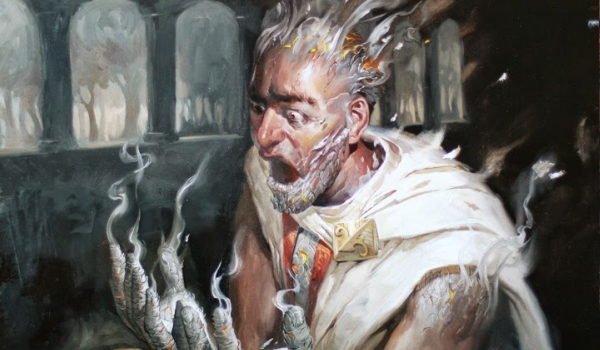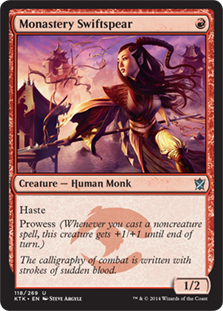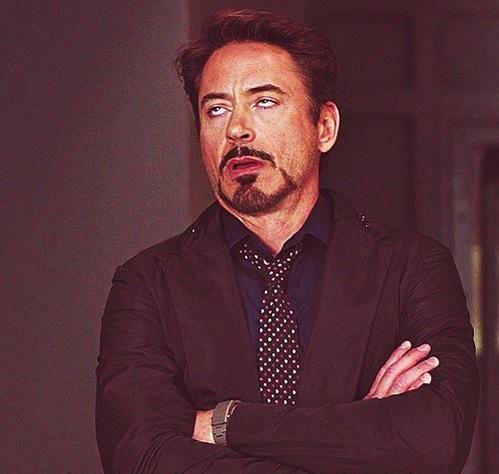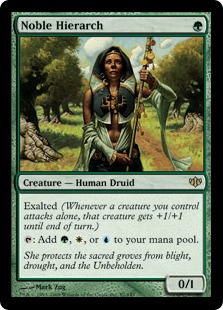Are you a Quiet Speculation member?
If not, now is a perfect time to join up! Our powerful tools, breaking-news analysis, and exclusive Discord channel will make sure you stay up to date and ahead of the curve.
I'm sure plenty of Modern players are unconcerned with the new Standard rotation, assuming that it will have little effect on them. Regarding card prices, though, it matters to everyone. Increasing the length of time that sets will stay in Standard will have a pretty big effect on the price of cards, and you need to know about it. It will also affect how Wizards of the Coast approaches reprints and the power level of cards in Standard. Today I'm going to walk you through the reasons why Modern players should care about the reverted Standard rotation.

As explained in Mark Rosewater's metamorphosis article, blocks were reduced last year from three to two sets, and the total number of concurrent blocks in Standard went up to three. Overall this changed the range of total sets in Standard from between 5-8 to between 5-6. Moving forward, every new block would cause a rotation of the oldest block, but this would take place twice a year—once in the fall and once in the spring.
Like many on the more competitive side of the spectrum, I thought this was a pretty great system, but apparently the greater Magic population didn't feel that way. Earlier this month, Aaron Forsythe announced that we were returning to the old rotation system to accommodate their concerns.
The new rotation schedule was slated to keep the first and second sets of each block in Standard for 18 months and 15 months, respectively. No matter when you bought your cards, they would have all had approximately the same lifetime in Standard. Now that we're returning to the once-per-year rotation, the fall set will be in Standard for 24 months while the summer set only gets 15 months. Typically, Standard-legal sets start to lose value approximately six months before they rotate—recently, this has coincided with the release of the block right before their rotation. Now that more sets will stay in Standard for longer, Modern players will have to wait a longer period of time to pick up Standard-legal cards at their lowest prices.
[wp_ad_camp_1]
Waiting Longer for Prices to Drop
Before the new rotation schedule, cards in the fall set of every year were the most sought-after and the most expensive on average throughout their lifetime in Standard. The rationale is that people are less reluctant to purchase cards with a longer life span and more likely to keep them. This means consumer confidence is high and the card's price will be higher than it would be in a set later in the year. The fall set is also usually the most popular and most purchased set, which tends to even out some of that demand. We can already see how reverting the rotation schedule has affected cards that are relevant to Modern, which should have been decreasing in price by now.
Gideon, Ally of Zendikar isn't a staple of Modern but he has appeared in the sideboard of some Abzan decks. If you were waiting to get some when they rotated you would be very confused by this spike. Prior to the announcement that Gideon will live another six months in Standard, I expected him to see a tiny uptick, if he was popular at the Pro Tour, and then to continue his descent until he rotated with the release of Amonkhet. Now that we know he won't rotate until next fall, he's basically been given a new lease on life. This probably feels miserable for Modern players who were waiting for his eventual fall to a reasonable rotation rate like Collected Company.
Collected Company decks were arguably the best decks in Standard before Kaladesh was released, and yet the card saw a steady decline starting immediately after Pro Tour Shadows over Innistrad, aka six months before it left Standard. With the change back to old rotations we will see more price graphs dipping during May, and that's basically it. Since four sets will rotate at once now, there is really only one good time per year to buy cards.
A Lower Power Level
My next argument is a little hard to show with data, but I think it makes sense logically. With the slower rotations there will be less room for R&D to make mistakes, which means they'll be more careful about introducing overpowered cards to the environment. For example, if Aetherworks Marvel is too good in Standard, the old rotation would have meant the deck only lasted for six months before Ulamog, the Ceaseless Hunger rotated in the spring.  Now with the longer length of time that sets stay in Standard, they may not be able to print cards as powerful as before.
Now with the longer length of time that sets stay in Standard, they may not be able to print cards as powerful as before.
The longer cards stay in Standard, the more damage a broken one can cause—and over-correction can cause problems too. For a period of time, Monastery Swiftspear, Eidolon of the Great Revel, and Atarka's Command all existed in Standard together and, much like the Modern Burn deck, ran amok. I don't necessarily think that Wizards of the Coast's development team considers those cards mistakes, but I wouldn't be surprised if some red cards in Battle for Zendikar got toned down to alleviate another Standard with an excessively fast aggressive red deck.
This is a net negative for Modern players, as it's already hard for new cards to break into eternal formats. They either need to spawn a whole new deck (Nahiri, the Harbinger), be a land (Spirebluff Canal), be brutally efficient (Monastery Swiftspear, Collected Company), or simply be the most powerful payoff card for a given strategy (Ulamog, the Ceaseless Hunger). These cards are few and far between. If cards are deemed too strong to exist in Standard for 24 months, they may get toned down enough to be too weak for Modern.
Fewer Reprints of Staples
Perhaps the header image tipped you off, but there's also the matter of Modern reprints. If you played during the Return to Ravnica/Theros Standard format you probably ran into this sequence a lot: Turn one Swamp, Thoughtseize taking your only removal spell. Turn two Mutavault, Pack Rat. Many people were victims of this basically unbeatable sequence, and as a result I saw many people who looked like this while playing Standard:

I'm not going to deny that the reprints of Mutavault and Thoughtseize were great for Modern players, but they were atrocious for Standard. When Mutavault and Pack Rat left Standard, they were quickly replaced in the Thoughtseize decks by Siege Rhino. Siege Rhino is a creature that sees a marginal amount of Modern play so it's not fair to pin all of the blame on Thoughtseize, but there was a lot of Abzan fatigue by the time it left. So as Wizards treads cautiously when it comes to power level in Standard, it will affect reprints as well as new card designs.
One reprint that Modern players would really like right now is enemy-colored fetchlands. Every set there are a million fingers crossed in hopes that the spoilers will contain Scalding Tarn. With the Battle for Zendikar dual lands now surviving next rotation, the likelihood of a reprint is pushed out another six months. We had a short time with fetches and battle lands and it ended up supporting the most obscene Standard mana bases we've seen since Reflecting Pool plus Vivid Creek. There is almost no chance they make that mistake again. That means Amonkhet is no longer my primary candidate to receive a fetchland reprint.
The Challenge of Meeting Reprint Demand
Cards in Standard get printed to demand. If there are players willing to buy and open booster packs that contain that card, more will get printed. The last time I can remember there ever being a real shortage of sealed product is during original Innistrad—these days it's basically unheard of.
 It is fantastic news for a card's price if it gets printed in an unlimited-print-run Standard set. Thoughtseize is 10% of its peak price. Mutavault is about 25% of its peak price. The allied-color fetchlands are 10-15% of their peak price. Even if you never play Standard, you can't argue that it's bad for Modern players when expensive cards get reprinted.
It is fantastic news for a card's price if it gets printed in an unlimited-print-run Standard set. Thoughtseize is 10% of its peak price. Mutavault is about 25% of its peak price. The allied-color fetchlands are 10-15% of their peak price. Even if you never play Standard, you can't argue that it's bad for Modern players when expensive cards get reprinted.
A decrease in the number of reprints in Standard-legal sets will lead to increased pressure on Modern Masters to deliver the reprints the format needs. As should be expected with any limited-print-run set, Modern Masters does not do enough to satisfy the demand for Modern-legal cards. Noble Hierarch is the poster child of a reprint policy that doesn't go far enough sometimes. If Noble Hierarch had been reprinted in Magic 2015 or another core set, it wouldn't be more than $20 right now. Increasing the amount of Modern Masters sets that get released every year might help with some of the reprint needs, but ultimately nothing is better for the price of a card than a Standard-legal reprint.
While this is true, however, you need to wait for cards to leave Standard to become affordable. When there were $30 Polluted Deltas in Standard they weren't a great pickup, but now you can buy a whole playset for about $60, less than a single Scalding Tarn. The reality of the situation is that slower rotations mean it's harder to reprint cards faster, and it will take longer for Modern to become more affordable.
Tying It All Together
So whether you play Modern, Legacy, or Commander, for eternal players the quicker Standard rotations were more likely to be in your favor. It's important to note that the trends that have been developing for the past year or so will no longer hold true. We will go back to a much more predictable and mundane price schedule, where we see cards start to dip in December a little bit, and then again in the Spring before rotation. If you're a player who was interested in acquiring a pile of Kaladesh fast lands for your collection, you'll have wait an extra six months before they become exceedingly affordable. As a result, you may just want to buy the ones you intend to play with in December because I'm not sure if it's worth waiting another 22 months for them to rotate.
As a side note, if you're a combo player who has shied away from Standard because it doesn't give you the ability to flex your combo muscles, I would recommend trying out the Aetherworks Marvel deck. It's not oppressively powerful, due to variance, but if you know how to limit your exposure to the variance (i.e. by having played a lot of combo) you may find yourself enjoying the deck a lot. I played it at Pro Tour Kaladesh, and had I constructed my deck a little better to beat counter spells and Spell Quellers, I may have ended with a much better record.







Is a lower power level in Standard really a negative for Modern though? For example with BFZ block Ulamog, the Ceaseless Hunger and World Breaker were obligatory additions to Tron. That’s money that could have been spent on other cards. I don’t see why Modern should be getting new (powerful) cards with every set.
It is a negative for modern from the view of a newer player. I can start to buy into Bant Eldrazi because the eldrazi creatures are available at good prices due to availability. It is a lot tougher to buy into Jund to due the number of old cards that simply won’t see the reprint numbers to lower the cost of Tarmogoyf, Liliana, or Dark Confidant.
Since WOTC will keep modern masters sets at ridiculous low print sets, what deck I want to play is severly limited. In my opinion everything should be reprinted virtually into the ground. No card should cost more than $50, but WOTC is oddly more beholden to collectors than players when it comes to old cards.
Those are pretty niche cards and they’re actually quite powerful for their mana cost. Most modern decks can’t support cards that cost 7 or 10.
In short, yes. In a major way, not just for newer players. Given what we understand about how wotc bans cards in Modern now, the longer a deck stays at the top, the more likely it is to see banning questions raised, alongside the other discussed parameters. Getting one card per set per color with modern intent behind it keeps the format from settling, and helps ensure that another twin ban doesn’t occur. In addition to which, there are certain things that modern seriously needs to open up space for a number of different archetypes: effectively costed and powered enemy colored commands come to mind first.
Hasnt wizards already stopped putting modern reprints in standatd sets? We might get a sylvan scrying but the days of thoughtseize, mutavault, and chord of calling seem to be over. They wont even do relatively innocent reprints like scapeshift or cavern of souls, let alone noble hierarchs and snapcasters.
And im also in the camp that modern can coast for a while without new cards shaking it up. Having a deck built and suddenly needing a playset of grim flayer to keep playing it gets old if it happens every set. We got a new t1 deck w eldrazi and some great toys for existing decks recently. Lets have the next shakeup be some unbans!
My point is that things like the Eldrazi deck are less likely to happen if they’re worried about a card being too powerful for an extended period of time in Standard.
You had three points. Longer wait for rotation price drops – yes. Lower power level – good, sick of needing to buy cards for eternal format. No more high profile reprints – already stopped reprinting anyways since seize muta chord – unless you count felidar sovereign.
Fetch lands are a big reprint and although this also introduced new ones to Modern, it also helped ease the prices of the Zendikar ones. Recently there haven’t been a lot of high profile reprints because they’ve been finishing a lot of Modern cycles that hadn’t existed (enemy color creature lands, enemy color fast lands, etc)
Aether Hub is mostly a function reprint of Tendo Ice Bridge.